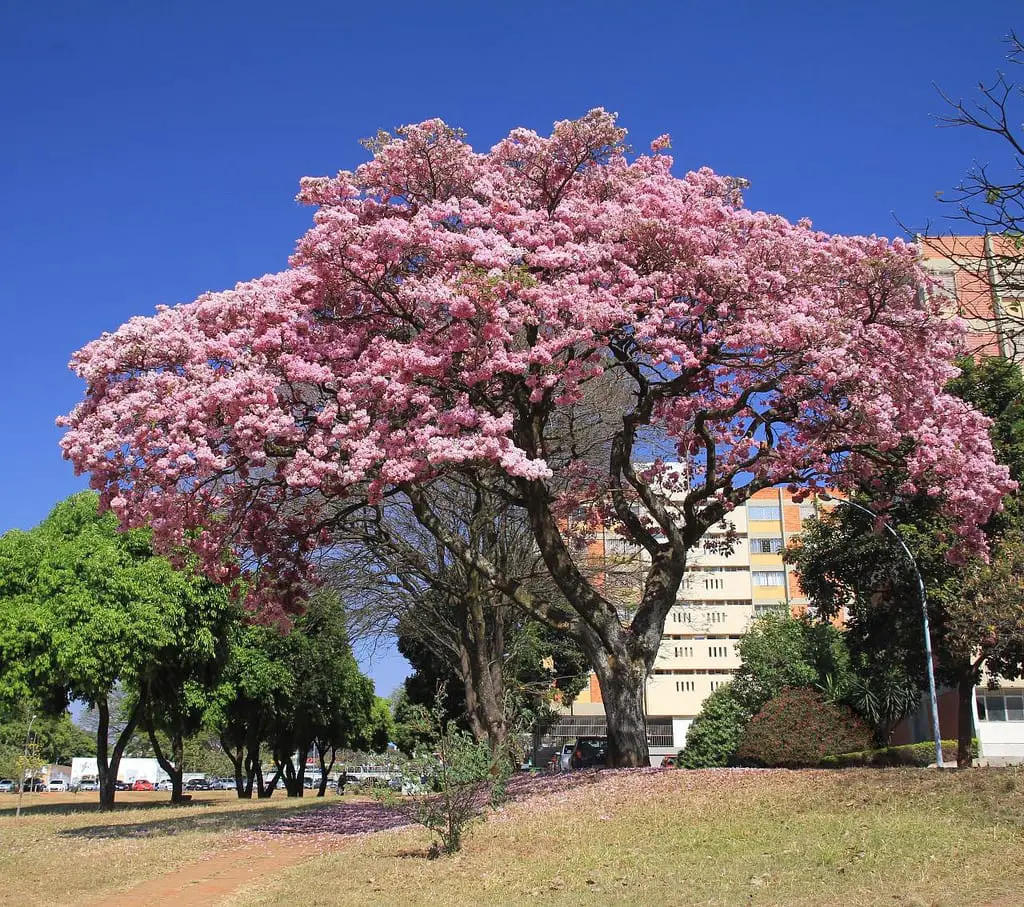
The here is the name given to the magnificent tropical trees of the botanical genus Tabebuia. These plants are native to the intertropical zone of America, with the Caribbean being home to most species.
Its flowering is spectacular. The flowers, which can be of several different colors, come to completely cover the crown, before it is filled with leaves. So if you are a lover of petals, do not hesitate to learn more about the lapacho.
What is the lapacho like?

The trees known as lapacho are deciduous plants that grow 4 to 10 meters high belonging to the genera Tabebuia and Handroanthus, which are made up of about 70 species native to tropical America. Its leaves are palmately foliolate, with each leaflet having very marked main and secondary veins. The flowers appear grouped in inflorescences in the form of a raceme of yellow, white, lilac, pink or red color. The fruit is a capsule inside which are thin and winged seeds, which have a high germination rate.
Its growth rate is reasonably fast if the weather is good, so They are very interesting plants for gardens since their root system is not invasive..
Main species
The best known are the following:
Tabebuia aurea

Image – Wikimedia Commons / Haneesh KM
It is a deciduous tree native to South America that reaches a height of 8 meters. It produces bright yellow flowers, with a diameter of 6,5 centimeters.
Tabebuia avellanedae / Handroanthus impetiginosus

Image – Wikimedia / mauroguanandi
Known as pink lapacho, is a native tree of Mexico and South America. Reaches a height of 30 metersand produces pink flowers of 4-5 centimeters.
Tabebuia chrysantha / Handroanthus chrysanthus

Image – Wikimedia / Veronidae
Known as guayacán, yellow guayacán, araguaney, yellow oak (not to be confused with the trees of temperate climates of the Quercus genus), or tajibo, it is a deciduous tree native to the American intertropical zone. Reaches a height of 5 to 8 metersand produces yellow flowers of 5 to 12 centimeters.
Tabebuia chrysotricha

Image – Flickr / Veronidae
Known as guayacán, golden trumpet tree or ipé, it is a deciduous tree native mainly to the Atlantic rainforest of Brazil that reaches a height of 7 to 11 meters. It produces yellow flowers.
Tabebuia heterophylla

Image – Wikimedia / mauroguanandi
Known as white oak (again, not to be confused with Quercus), it is a deciduous tree native to the Lesser Rings that reaches a height of up to 18 meters. It produces pink flowers of about 5-6 centimeters.
How do you take care of yourself?
Would you like to have one in your paradise? Follow our advice:
Location
It is a plant that must be outside, in full sun. In order for it to flourish, it needs direct sunlight, ideally all day long.
Land
- the garden: it is important that it is rich in organic matter and that it has good drainage, as it does not like too much waterlogging.
- Flower pot: fill with universal substrate, mulch or compost, mixed with 20% perlite or similar.
Irrigation
Generally, must be frequent. In hot, dry climates, it may be necessary to water every 2-3 days in summer, and every 3-4 days the rest of the year. In any case, this may vary, since for example a tree that is in a pot will not need the same frequency of watering as another that is planted in the garden.
So, in case of doubt, do not hesitate to check the humidity, because if it suffers from excessive watering it will be difficult to recover the lapacho.
Subscriber

From spring to summer must be paid with organic fertilizers, such as earthworm humus o horse manure. If it is in a pot, use liquid fertilizers following the indications specified on the container; in this way, there will be no risk of overdose.
Pruning
You don’t really need it. It will be enough to remove the dry, weak and diseased branches in autumn. Always use pruning tools previously disinfected, clean, and in good condition.
Planting time
If you feel like planting it in the garden, you can do it in spring. In the case that you are growing it in a pot, transplant it also in that season when you see that the roots come out through the drainage holes, or when more than two years have passed since the last transplant.
Multiplication
The lapacho multiplies by seeds in spring, and by cuttings in autumn or spring:
Seeds
To get the seeds to germinate We recommend keeping them in a glass of water for 24 hours, and then sowing them in seedling trays or pots. with holes in its base filled with universal substrate mixed with 30% perlite or similar.
Keeping the substrate humid, and the seedbed outside, they will germinate in about 15 days at a temperature of about 20ºC.
Cuttings
Cut a piece of about 30 centimeters, impregnate its base with homemade rooting agents, and then plant it in a pot with vermiculite previously watered. Put it outside, in a bright area but protected from direct sun.
If everything goes fine, about a month will emit its roots.
Rusticity
It is sensitive to frost and cold. To give you an idea, I had a yellow guayacán that I obtained from seed and as soon as the temperature dropped below 10ºC I began to lose it.
Where to buy?
Outside their places of origin it is difficult to find it, so you have to look for seeds that they sell for example here:
No products found.
Did you know the lapacho?
